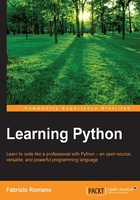
What this book covers
Chapter 1, Introduction and First Steps – Take a Deep Breath, introduces you to fundamental programming concepts. It guides you to getting Python up and running on your computer and introduces you to some of its constructs.
Chapter 2, Built-in Data Types, introduces you to Python built-in data types. Python has a very rich set of native data types and this chapter will give you a description and a short example for each of them.
Chapter 3, Iterating and Making Decisions, teaches you how to control the flow of your code by inspecting conditions, applying logic, and performing loops.
Chapter 4, Functions, the Building Blocks of Code, teaches you how to write functions. Functions are the keys to reusing code, to reducing debugging time, and in general, to writing better code.
Chapter 5, Saving Time and Memory, introduces you to the functional aspects of Python programming. This chapter teaches you how to write comprehensions and generators, which are powerful tools that you can use to speed up your code and save memory.
Chapter 6, Advanced Concepts – OOP, Decorators, and Iterators, teaches you the basics of object-oriented programming with Python. It shows you the key concepts and all the potentials of this paradigm. It also shows you one of the most beloved characteristics of Python: decorators. Finally, it also covers the concept of iterators.
Chapter 7, Testing, Profiling, and Dealing with Exceptions, teaches you how to make your code more robust, fast, and stable using techniques such as testing and profiling. It also formally defines the concept of exceptions.
Chapter 8, The Edges – GUIs and Scripts, guides you through an example from two different points of view. They are at the extremities of a spectrum: one implementation is a script and the other one a proper graphical user interface application.
Chapter 9, Data Science, introduces a few key concepts and a very special tool, the Jupyter Notebook.
Chapter 10, Web Development Done Right, introduces the fundamentals of web development and delivers a project using the Django web framework. The example will be based on regular expressions.
Chapter 11, Debugging and Troubleshooting, shows you the main methods to debug your code and some examples on how to apply them.
Chapter 12, Summing Up – A Complete Example, presents a Django website that acts as an interface to an underlying slim API written with the Falcon web framework. This chapter takes all the concepts covered in the book to the next level and suggests where to go to dig deeper and take the next steps.